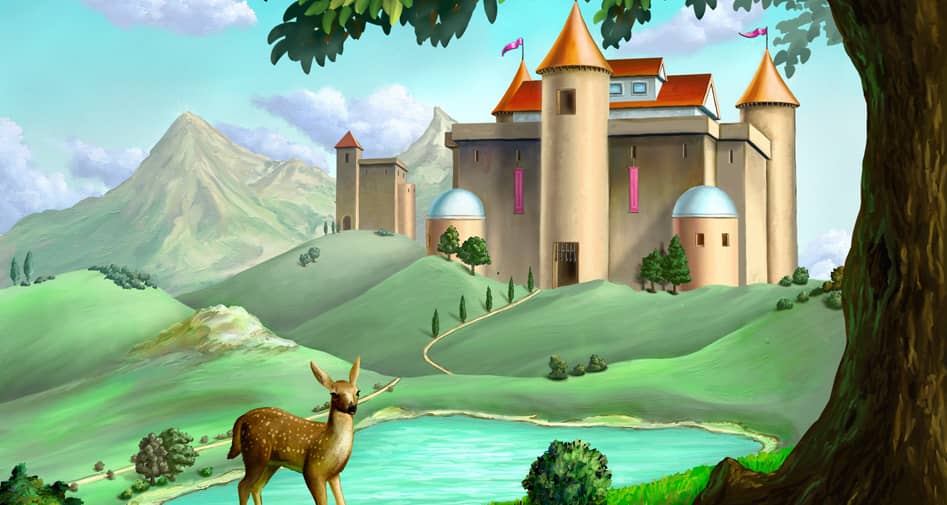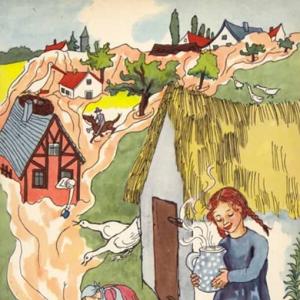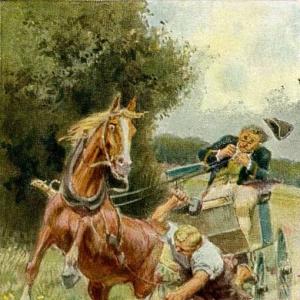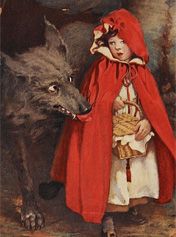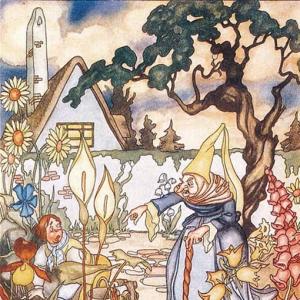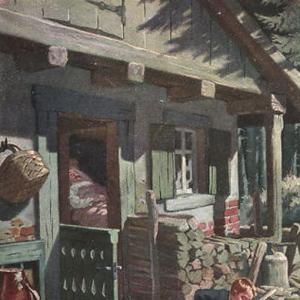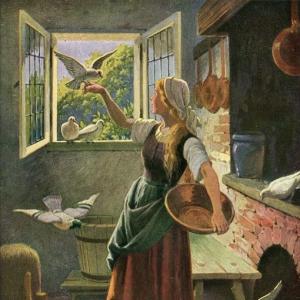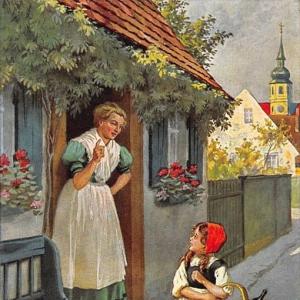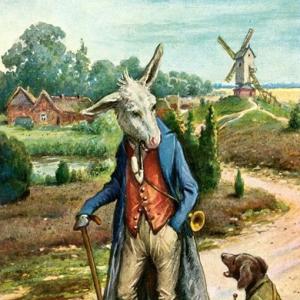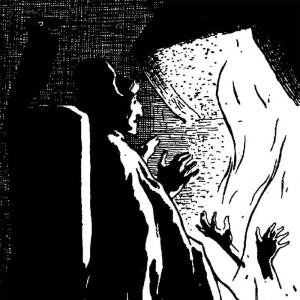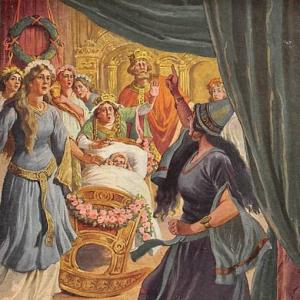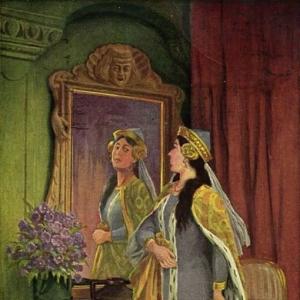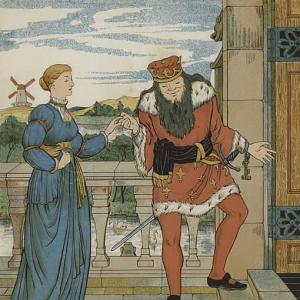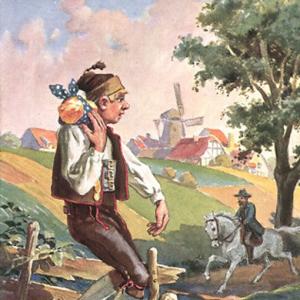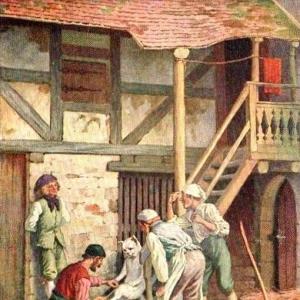Reading time for children: 5 min
A poor peasant-boy one day heard the priest say in church that whosoever desired to enter into the kingdom of heaven must always go straight onward. So he set out, and walked continually straight onwards over hill and valley without ever turning aside. At length his way led him into a great town, and into the midst of a church, where just at that time God’s service was being performed. Now when he beheld all the magnificence of this, he thought he had reached heaven, sat down, and rejoiced with his whole heart. When the service was over, and the clerk bade him go out, he replied, „No, I will not go out again, I am glad to be in heaven at last.“ So the clerk went to the priest, and told him that there was a child in the church who would not go out again, because he believed he was in heaven. The priest said, „If he believes that, we will leave him inside.“ So he went to him, and asked if he had any inclination to work. „Yes,“ the little fellow replied, „I am accustomed to work, but I will not go out of heaven again.“ So he stayed in the church, and when he saw how the people came and knelt and prayed to Our Lady with the blessed child Jesus which was carved in wood, he thought „that is the good God,“ and said, „Dear God, how thin you are! The people must certainly let you starve; but every day I will give you half my dinner.“ From this time forth, he every day took half his dinner to the image, and the image began to enjoy the food. When a few weeks had gone by, people remarked that the image was growing larger and stout and strong, and wondered much. The priest also could not understand it, but stayed in the church, and followed the little boy about, and then he saw how he shared his food with the Virgin Mary, and how she accepted it. After some time the boy became ill, and for eight days could not leave his bed; but as soon as he could get up again, the first thing he did was to take his food to Our Lady. The priest followed him, and heard him say, „Dear God, do not take it amiss that I have not brought you anything for such a long time, for I have been ill and could not get up.“ Then the image answered him and said, „I have seen thy good-will, and that is enough for me. Next Sunday thou shalt go with me to the wedding.“ The boy rejoiced at this, and repeated it to the priest, who begged him to go and ask the image if he, too, might be permitted to go. „No,“ answered the image, „thou alone.“ The priest wished to prepare him first, and give him the holy communion and the child was willing, and next Sunday, when the host came to him, he fell down and died, and was at the eternal wedding.
 Learn languages. Double-Tap on one word.Learn languages in context with Childstories.org and Deepl.com.
Learn languages. Double-Tap on one word.Learn languages in context with Childstories.org and Deepl.com.Backgrounds to fairy tale „The heavenly wedding“
„The Heavenly Wedding“ (also known as „The Wedding of Mrs. Fox“ or „Die Hochzeit der Frau Füchsin“ in German) is another lesser-known fairy tale collected by the Brothers Grimm in their compilation „Grimm’s Fairy Tales.“ As German academics and linguists, Jacob and Wilhelm Grimm collected and preserved folklore and traditional tales, first publishing their collection in 1812. The collection contains several famous fairy tales, such as „Cinderella,“ „Hansel and Gretel,“ „Snow White,“ and „Rapunzel,“ and has significantly influenced the development of Western literature and popular culture.
„The Heavenly Wedding“ is a clever and witty story that centers around a fox couple, Mr. and Mrs. Fox. When Mr. Fox dies, Mrs. Fox declares that she will only remarry if she finds a suitor whose tail is as magnificent as her late husband’s. Several animals come to court Mrs. Fox, but none have tails that match Mr. Fox’s beauty. Eventually, a young fox with a splendid tail arrives and wins Mrs. Fox’s hand in marriage. The story concludes with a grand wedding celebration attended by various animals.
The tale is unique in its anthropomorphic portrayal of animals, with the characters exhibiting human-like behaviors, emotions, and social customs. This approach is a common feature in folktales and serves to make the story engaging and relatable while also providing a platform for teaching moral lessons or reflecting on human nature.
„The Heavenly Wedding“ is believed to be of German origin, but the specific source of the tale is unknown. The Brothers Grimm gathered their stories from various sources, including oral traditions, manuscripts, and printed materials. The story has been retold and adapted in different forms, such as written works, audio recordings, and visual media, although it has not gained the same level of popularity as some of the more famous Grimm’s Fairy Tales.
Interpretations to fairy tale „The heavenly wedding“
„The Heavenly Wedding“ (or „The Wedding of Mrs. Fox“) is a unique and whimsical tale that can be interpreted in various ways. Here are some possible interpretations of the story:
Selective Love and Compatibility: The story emphasizes the importance of compatibility and finding a suitable partner in marriage. Mrs. Fox’s insistence on finding a suitor with a tail as magnificent as her late husband’s showcases her selective approach to love, and the importance she places on physical attributes that she finds desirable in a partner.
Anthropomorphism and Satire: The use of anthropomorphism in the story, with animals displaying human-like behaviors and emotions, can be seen as a satirical commentary on human society and social customs, particularly around courtship and marriage. By depicting animals engaging in these human rituals, the tale humorously highlights the sometimes superficial nature of our societal norms.
Persistence and Patience: Mrs. Fox’s search for a suitable partner requires her to be patient and persistent, as she meets several suitors who fail to meet her expectations. This aspect of the story can be interpreted as a lesson in the importance of patience and perseverance when seeking a desirable outcome.
Social Status and Appearances: The emphasis on the beauty of Mr. Fox’s tail and Mrs. Fox’s determination to find a suitor with an equally impressive tail may be seen as a reflection of the importance of social status and appearances in society. The story can be interpreted as a commentary on the way people often prioritize external factors, such as beauty or wealth, when choosing a partner.
Celebration of Individuality: The fact that no two suitors have identical tails in the story could be seen as a celebration of individuality and the idea that each person (or animal, in this case) possesses unique traits that make them special. The tale encourages readers to appreciate and embrace these differences, rather than seeking conformity or sameness.
Traditional Gender Roles: The story can also be interpreted as a reflection of traditional gender roles, with the female character, Mrs. Fox, seeking a partner to provide and care for her following the death of her husband. This perspective highlights the historical expectations placed on women to find a suitable spouse for protection and stability.
While „The Heavenly Wedding“ may not be as well-known as some other Grimm’s Fairy Tales, its unique narrative and anthropomorphic characters offer a variety of interpretations and insights into human behavior and societal norms.
Adaptions of the fairy tale „The heavenly wedding“
Although „The Heavenly Wedding“ (or „The Wedding of Mrs. Fox“) is not as well-known as other Grimm’s Fairy Tales, it has still been adapted and retold in various forms. Here are some examples of adaptations of the story:
Books and Written Adaptations: The story has been included in numerous collections of fairy tales, with some authors adapting the language, setting, or character names to make the story more accessible to contemporary readers. For example, „The Heavenly Wedding“ may appear in a collection of lesser-known Grimm’s Fairy Tales or animal-themed folktales.
Audio Adaptations: „The Heavenly Wedding“ could be adapted into an audiobook or podcast form, either as a standalone recording or as part of a collection of fairy tales. These adaptations may feature voice actors, sound effects, and music to bring the story to life and make it engaging for listeners.
Theater and Puppet Shows: The anthropomorphic characters and humorous elements of the story lend themselves well to theatrical adaptations, such as stage plays or puppet shows. A local theater group might produce a play based on „The Heavenly Wedding,“ or a puppeteer might create a puppet show retelling the tale.
Animation and Film: Although there are no widely known film adaptations of „The Heavenly Wedding“ specifically, the story’s anthropomorphic characters and humorous plot could make for an entertaining animated short film or feature. Independent animators or filmmakers might create a film based on the story, emphasizing the unique elements that set it apart from other fairy tales.
Art and Illustration: The story’s vivid imagery and charming animal characters provide ample opportunities for creative visual storytelling through art and illustration. „The Heavenly Wedding“ may have inspired illustrations in fairy tale collections, standalone artworks, or even graphic novel adaptations.
While „The Heavenly Wedding“ may not have as many well-known adaptations as some other Grimm’s Fairy Tales, its unique narrative and engaging characters offer a variety of opportunities for reinterpretation and retelling in different forms.
Adaptions of the fairy tale „The heavenly wedding“
„The Heavenly Wedding“ has inspired many adaptations and retellings in various forms of media. Here are a few notable adaptations:
„The Invisible Prince“ by Mary Jane Beaufrand: This young adult novel is a modern retelling of „The Heavenly Wedding.“ The story follows a teenage girl who falls in love with an invisible prince and must navigate the challenges of their relationship.
„The Glass Mountain“ by Diana Wynne Jones: This novel for young readers is a retelling of „The Princess on the Glass Hill,“ which is a similar fairy tale to „The Heavenly Wedding.“ The story follows a young man who must climb a glass mountain to win the hand of a princess who is guarded by an invisible being.
„Cinderella“ (2015 film): This live-action adaptation of the classic fairy tale features a scene in which the fairy godmother turns Cinderella’s pumpkin into a carriage and her mice into horses. This scene is reminiscent of the transformation of the young woman in „The Heavenly Wedding“ into a goddess or a fairy after the wedding.
„East of the Sun and West of the Moon“ by Jackie Morris: This children’s book is a retelling of a Norwegian folktale that shares many similarities with „The Heavenly Wedding.“ The story follows a young woman who must journey to a distant land to rescue her true love, who is held captive by an invisible troll.
„Barbie in the 12 Dancing Princesses“ (2006 film): This animated film for children features a scene in which the twelve princesses are transported to a magical world where they dance with invisible princes. This scene is reminiscent of the invisible wedding in „The Heavenly Wedding.“
Overall, „The Heavenly Wedding“ has inspired numerous adaptations and retellings, demonstrating the enduring appeal of this timeless fairy tale.
Summary of the plot
„The Heavenly Wedding“ (also known as „The Wedding of Mrs. Fox“) is a whimsical fairy tale from the Brothers Grimm. The story revolves around a fox couple, Mr. and Mrs. Fox. When Mr. Fox dies, Mrs. Fox decides that she will only remarry if she finds a suitor with a tail as magnificent as her late husband’s.
Several animals come to court Mrs. Fox, but none have tails that match the beauty of Mr. Fox’s tail. Eventually, a young fox with an impressive tail arrives and wins Mrs. Fox’s approval. The story concludes with a grand wedding celebration attended by various animals.
Through its anthropomorphic characters and humorous plot, „The Heavenly Wedding“ provides a unique and entertaining look at themes such as love, compatibility, and the importance of appearances in society.
———-
Backgrounds to fairy tale „The heavenly wedding“
„The Heavenly Wedding“ is a fairy tale collected by the Brothers Grimm, two German scholars and cultural researchers, Jacob and Wilhelm Grimm. They are best known for their collection of German and European folktales, which they compiled and published as „Grimm’s Fairy Tales“ (originally titled „Children’s and Household Tales“ or „Kinder- und Hausmärchen“) in 1812.
The Brothers Grimm collected these stories from various sources, such as oral traditions, written manuscripts, and other storytellers. Their goal was to preserve the cultural heritage and history of the German people, which was at risk of being lost due to rapid industrialization and urbanization. The collection includes well-known stories like „Cinderella,“ „Snow White,“ „Rapunzel,“ and „Hansel and Gretel,“ as well as lesser-known tales like „The Heavenly Wedding.“
The Grimm brothers‘ collection of fairy tales has become an essential part of the Western literary canon and has influenced countless authors, artists, and filmmakers. The tales often contain elements of magic, symbolism, and moral lessons that have resonated with audiences across generations.
„The Heavenly Wedding,“ like many other Grimm fairy tales, incorporates themes of faith, love, devotion, and the power of intention. The story also touches upon the importance of the church as a sanctuary for spiritual growth and the transience of earthly life. The fairy tale serves as a reminder to prioritize spiritual values and connections, reflecting the religious and cultural context of the time in which it was collected.
Interpretations to fairy tale „The heavenly wedding“
„The Heavenly Wedding“ can be interpreted on multiple levels, reflecting various themes and messages:
Faith and Innocence: The boy’s pure and unwavering faith leads him to believe that he has found heaven on Earth. His innocence allows him to see the divine in the church and the carved image, fostering a strong connection with the divine.
Devotion and Generosity: The boy’s selflessness in sharing his food with the image of the Virgin Mary and Jesus exemplifies devotion and generosity. His actions bring about a miracle, as the image grows larger and stronger, showing that acts of kindness and love can have a powerful impact.
The Power of Intention: The boy’s actions are driven by his genuine desire to care for what he believes to be the divine. His good intentions are acknowledged by the image, demonstrating that sincerity and good will are valuable spiritual qualities.
The Transience of Earthly Life: The boy’s death at the end of the story reminds readers that life is temporary and that the ultimate goal is to join the eternal heavenly wedding. His readiness to leave the earthly realm symbolizes the importance of prioritizing spiritual growth and connection to the divine.
The Role of the Church: The church serves as both a literal and metaphorical space for the boy’s spiritual journey. It provides a sanctuary where he can connect with the divine and fulfill his mission of devotion and generosity.
In summary, „The Heavenly Wedding“ highlights the themes of faith, innocence, devotion, generosity, the power of intention, the transience of life, and the role of the church in one’s spiritual journey. The story encourages readers to cultivate these virtues and seek a deeper connection with the divine.
Summary of the plot
„The Heavenly Wedding“ is a fairy tale by the Brothers Grimm, which tells the story of a poor peasant boy who, after hearing a priest say that the way to enter the kingdom of heaven is to always go straight onward, sets out on a journey. He walks continually without turning aside, eventually reaching a grand church in a large town. Believing he has arrived in heaven, the boy decides to stay and is allowed to do so by the priest, who is impressed by the boy’s faith.
The boy is diligent in his work at the church and, when he notices a wooden carving of the Virgin Mary with the baby Jesus, he believes it to be the „good God“ and vows to share his meals with the figure. As he feeds the image daily, it begins to grow larger and stronger, which astonishes the townspeople and the priest. Curious, the priest observes the boy and discovers that he is sharing his food with the image, which seems to accept it.
When the boy falls ill for eight days, he is unable to bring food to the image. Once recovered, he resumes his offerings, apologizing to the image for his absence. The image speaks to the boy, expressing gratitude for his good intentions and inviting him to the heavenly wedding on the following Sunday. The boy excitedly shares the news with the priest, who requests to attend the wedding as well but is denied by the image.
Prepared for the wedding with holy communion, the boy receives the host and, in that moment, dies. Thus, his soul joins the eternal wedding in heaven. The tale emphasizes faith, devotion, and the transformative power of love and kindness.
Informations for scientific analysis
Fairy tale statistics | Value |
|---|---|
| Number | KHM 209 |
| Aarne-Thompson-Uther-Index | ATU Typ 767 |
| Translations | DE, EN |
| Readability Index by Björnsson | 33.8 |
| Flesch-Reading-Ease Index | 76.1 |
| Flesch–Kincaid Grade-Level | 8.8 |
| Gunning Fog Index | 11.2 |
| Coleman–Liau Index | 7.1 |
| SMOG Index | 8.4 |
| Automated Readability Index | 9.3 |
| Character Count | 2.639 |
| Letter Count | 2.020 |
| Sentence Count | 21 |
| Word Count | 519 |
| Average Words per Sentence | 24,71 |
| Words with more than 6 letters | 47 |
| Percentage of long words | 9.1% |
| Number of Syllables | 648 |
| Average Syllables per Word | 1,25 |
| Words with three Syllables | 17 |
| Percentage Words with three Syllables | 3.3% |
